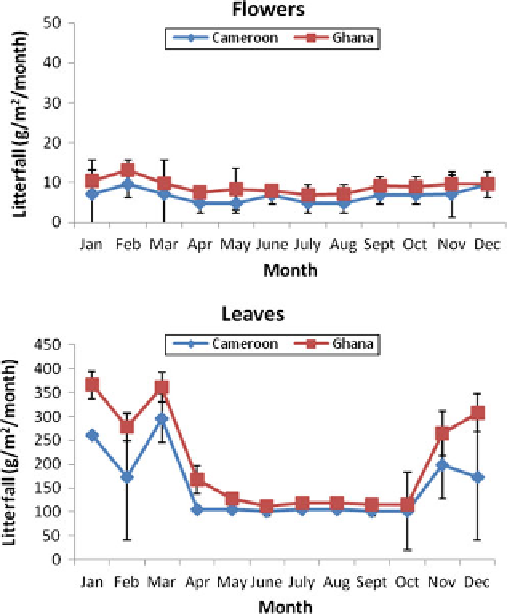Environmental Engineering Reference
In-Depth Information
Fruits
Cameroon
Ghana
40
30
20
10
0
Jan
Feb
Mar
Apr
May June July
Aug
Sept
Oct
Nov
Dec
-10
-20
Month
Twigs
Cameroon
Ghana
45
40
35
30
25
20
15
10
5
0
-5
Jan Feb Mar Apr May June July Aug Sept Oct Nov Dec
Month
Fig. 14
Total monthly litterfall component in mixed stands in Cameroon and Ghana
Mangrove Litterfall Production
13
) that mixed stands is significantly larger in terms of
mean height (25.1 m), average basal area (32.76 m
2
/ha) and
mean
(466.22 m
3
)
Litter Composition
A substantial portion of mangrove products returns to the
environment in the form of litterfall. This is an important
source of organic detritus, which supports important detrital
marine food webs (Odum and Heald
1975
; FAO
2007
;
Conchedda et al.
2011
). It is a direct food source for various
herbivore crustacean and molluscs. Table
1
and Fig.
14
show the monthly dry weight of litterfall in the mangrove
forests of Cameroon and Ghana. Litterfall rate is seasonal,
generally being low in the rainy season and high in the dry
season (Nfotabong Atheull
2011
; Worlanyo Aheto
2011
). In
Ghana, the total dry weight of litterfall was 278 g/m
2
/year
(9.15 %) of flowers, 143 g/m
2
/year (4.71 %) of fruits/seeds,
2,467 g/m
2
/year (81.28 %) of leaves and 147 g/m
2
/year
(4.84 %) of twigs. In Cameroon, the total dry weights for
flowers, fruits/seeds, leaves and twigs were, respectively,
231 g/m
2
/year (4.26 %), 247 g/m
2
/year (4.56 %), 4,608 g/
m
2
/year (85.17 %) and 324 g/m
2
/year (5.98 %).
volume
in
Cameroon
and
density
(10,200 stems/ha) in Ghana.
From this research, it has been observed that Ghana has
the mean highest species density, with 10,200 stems/ha
(Figs.
11
,
12
, and
13
). Cameroon has lower density
(6,100 stems/ha) of smaller size with a larger basal area
(BA = 32.76 m
2
/ha). Before this zone has been designated
as protected area, large mangrove trees were cut as con-
struction materials and firewood for bakeries that resulted in
denser trees of smaller size (BA = 76.07 m
2
/ha). This may
be due to less utilization of large mangrove trees since the
economic activities in this area were charcoal making and
firewood selling, which utilized the smaller size of man-
grove trees (Adjonina
2008
; Chen et al.
2009
; Nfotabong
Atheull
2008
,
2011
; Aheto
2011
; Dahdouh-Guebas
2011
).
The highest average canopy height was in Cameroon
(25.1 m), the lowest in Ghana (4.7 m) (Figs.
11
,
12
, and
13
). This can be attributed to less pressure to utilize the
trees due to the vast mangrove area and relatively small
human population compared with the mangrove area in
Cameroon. The mixed stands in Cameroon had the highest
basal area (32.76 m
2
/ha), with a high average height of only
25.1 m showing that mangrove species in mixed stands
were more or less well conserved.
Total Annual Litterfall
For Ghana sites, the total annual litterfall was 3,035 g/m
2
/
year or 30.3 t/ha (average value: 2.5 t/ha), consisting of
Avicennia (27.47 %), Rhizophora (48.66 %) and mixed
(23.85 %). Leaf litterfall comprised the largest component























































































































































































































































Search WWH ::

Custom Search